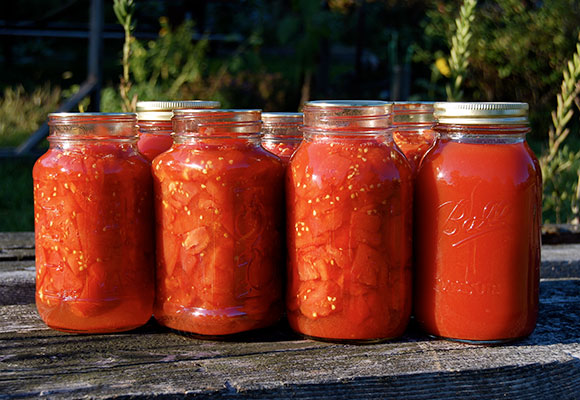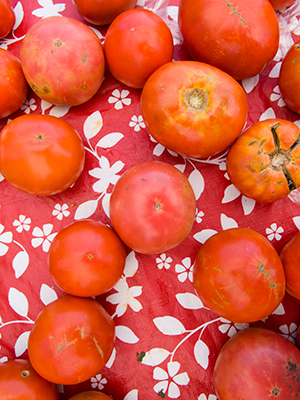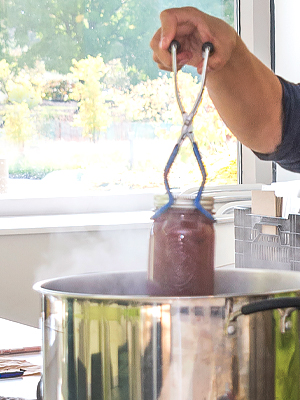Tomato Talk
A Full Season of Tomato-Growing Information
Canning & Sauces
There is nothing like opening a jar of home-canned tomatoes on a cold, snowy January day. The bright color and aroma of tomatoes, whether in a rich tomato sauce or as a base for salsa, bring back the warmth and long sunny days of summer. Canning is also a great way to make the most of your harvest—especially any not-so-perfect produce. Start when there’s a bounty of fruits and vegetables from your home garden or the local farmers’ market.

Enjoying home-canned tomatoes later in the fall or winter is one of the most rewarding parts of growing your own vegetables.
Canning is a method of preserving food that applies heat in a glass canning jar to stop the natural spoilage by heating the contents and removing air from the jar to create a seal. There are two home-canning methods: water-bath canning and pressure canning. Water-bath canning is the lower-temperature canning process that works for high-acid foods like jams, pickles, and salsas. Tomatoes can also be processed this way with additional acid (such as lemon juice). The high acidity kills bacteria, ensuring the food stays well preserved. Pressure canning is a higher-temperature process that is required for safe processing of low-acid foods like beans, zucchini, and pumpkin. Because this process requires special equipment, we’re focusing on water-bath canning.
Canning safety:
It is important to have the correct amount of high-acid ingredients using the water-bath canning process. You can safely make tweaks to the seasonings, but it is essential to have the correct ratio of low- and high-acid ingredients to ensure a solution that is acidic enough to kill any bacteria. Canning homemade recipes can be risky if they haven't been tested for proper pH levels. Without enough acid in a canning recipe, mold or harmful bacteria like botulism can form.
What you need:
Jars: Canning jars are heavy glass jars, also known as mason jars. They come in all different shapes and sizes from squat 4-ounce jars for chutneys and jams to half-gallon jars for juices and large batches of sauce. They come in different colors and designs to suit every purpose. Jars come with lids and bands, but replacements may be purchased separately.
Lids and bands: Canning jar lids come in two parts—lids and bands. The lid is a metal disk with a layer of plastisol on the bottom. These disks cover the top of the jar, and the layer of plastisol creates an airtight seal as the food inside cools. We recommend using Ball or Kerr lids, because they have been proven BPA free. Lids should only be used once for safety purposes. After the first use, the seal may become unreliable. Bands make up the other part of the lid. They form the part that screws down the lid and fixes it to the jar. These can be used multiple times, but should be discarded if rusty or dented.
Large pot or canner: Any large stock or stew pot will work, but you will need a rack to hold jars off the bottom. (Jars that sit on the bottom of the pot of boiling water may crack during processing.) If you don’t already own something like this, you may choose to invest in a canner that can be used for canning as well as other large-batch cooking.
Accessories: There are endless accessories that can streamline the canning process, including canning tongs for lifting hot jars, funnels for pouring into jars, and tools for measuring headspace and removing bubbles. They’re all helpful, but optional.
And of course…your favorite fresh fruits and veggies!


Canning Tips:
Sterilize your jars. To sterilize jars, submerge the jars and boil them for at least ten minutes. Some dishwashers also have a sterilize setting. While some believe this step is not necessary if you will be processing your recipe for more than ten minutes, we err on the side of caution. We don’t recommend using the oven to sterilize, as some jars are not made for dry heat and may crack when removed from the oven.
Only use canning lids once. After the first use, the lid may no longer seal effectively and you risk having to repeat the process, or spoilage. You may use the bands multiple times.
Use a tested recipe by a trusted source. With tested recipes, you can be confident that they have a safe pH level. Ball has more than 500 tested recipes available online at freshpreserving.com/recipes.
Prepare your ingredients ahead of time. Canning, like cooking anything else, is a fast-paced endeavor once you get started. Having all your ingredients prepped and measured before you start will make the process go smoothly.
Make sure your jars seal. Once cooled, there should be no give in the lids. If you push down on the lid and feel or hear a small pop, there is give. Either put the jar in the fridge to eat right away, or reprocess that batch.
Resources
USDA Complete Guide to Canning: http://nchfp.uga.edu/publications/publications_usda.html
Ball recipes, supplies, and canning tips: freshpreserving.com/home

